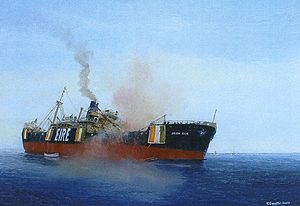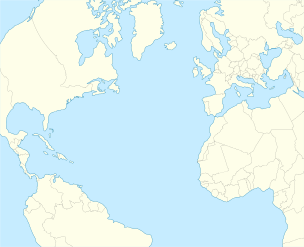 Oil painting by Kenneth King depicting the moments after the Irish Oak was torpedoed after first lifeboat had just been lowered (National Maritime Museum of Ireland).
| |
| History | |
|---|---|
| Name |
|
| Owner |
|
| Operator |
|
| Port of registry |
|
| Route | Cork – Tampa (1941–43) |
| Builder | Southwestern Shipbuilding, San Pedro, Los Angeles |
| Yard number | 11 |
| Launched | 24 August 1919 |
| Completed | December 1919 |
| Out of service | 1935–41 |
| Identification |
|
| Fate | Torpedoed and sunk by U-607, 15 May 1943 |
| Notes | Built to Design 1019 |
| General characteristics | |
| Tonnage | |
| Length | 410.5 ft (125.1 m)[1] |
| Beam | 54.3 ft (16.6 m)[1] |
| Depth | 27.2 ft (8.3 m)[1] |
| Installed power | 359 NHP[1] |
| Propulsion | Triple-expansion steam engine, Llewellyn Iron Works, Los Angeles[1] |
| Speed | 10.5 knots (19.4 km/h) |
The SS Irish Oak was an Irish-operated steamship that was sunk in the North Atlantic during World War II by a German submarine.
As the West Neris, she had been built in the United States and operated by the US Shipping Board. In 1941, she was chartered by Irish Shipping Limited to transport wheat and fertilizer from North America to Ireland. Sailing as a clearly marked neutral vessel and not in convoy, she was nonetheless torpedoed and sunk by U-607 on 15 May 1943 midway between North America and Ireland with the crew being rescued.
There were then both conflicting reports that she had not, and allegations that she had, warned a nearby convoy of the presence of a U-boat. The British nationality of her captain became an issue in the June 1943 Irish general election, there were diplomatic exchanges between the United States and the Republic of Ireland and questions raised in the British House of Commons. In Germany, the U-boat's captain received a mild reprimand.
